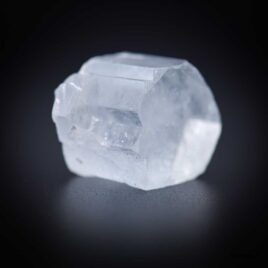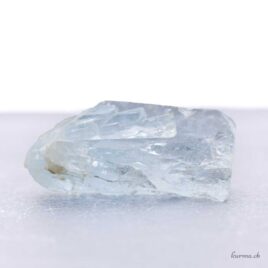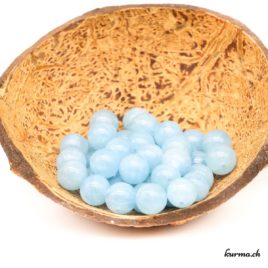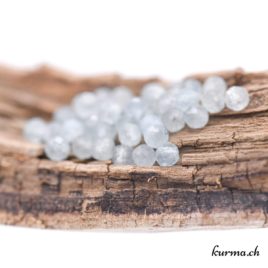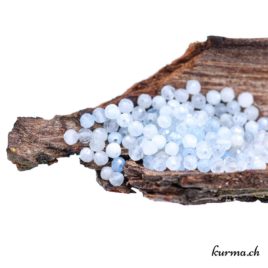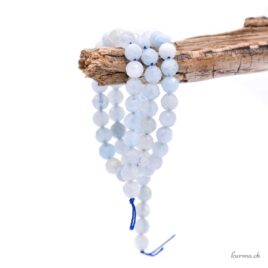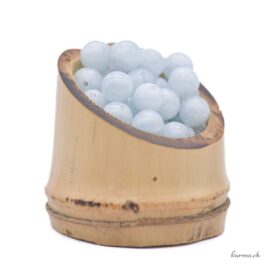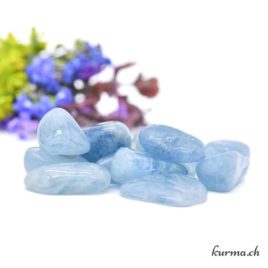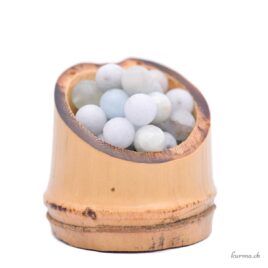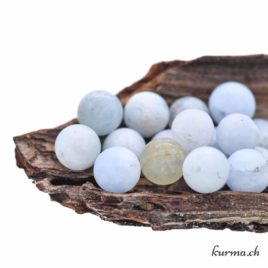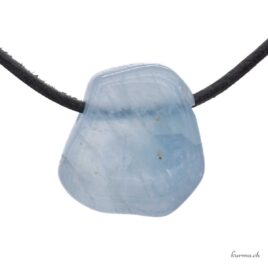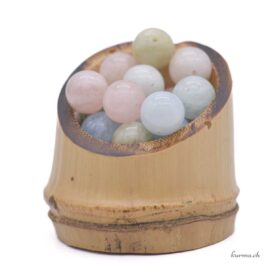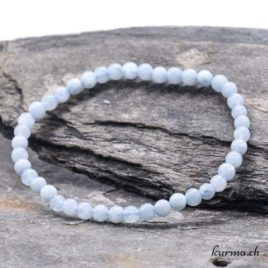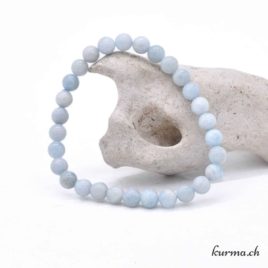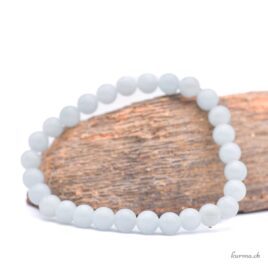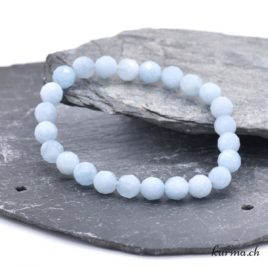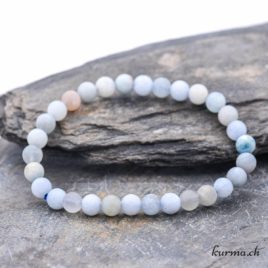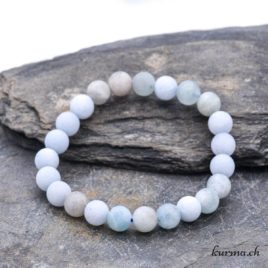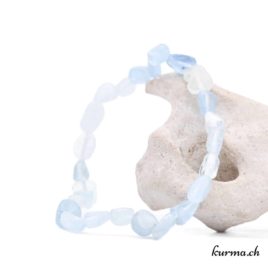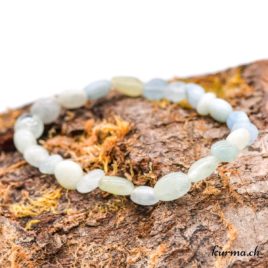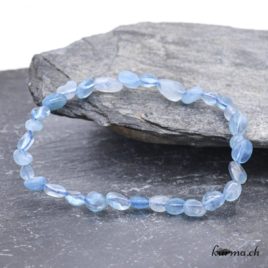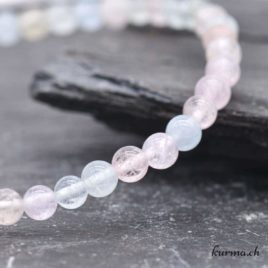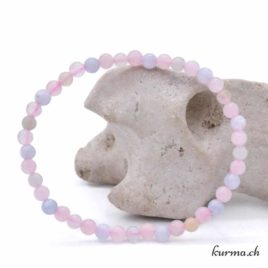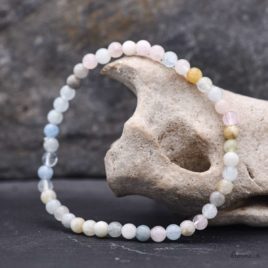Aquamarine / Aquamarine / Blue beryl
gemstones light blue, blue-green
Aquamarine, aquamarine or blue beryl, a semi-precious natural stone, has fascinated people for centuries with its brilliance and dreamlike color.
This light blue to blue-green crystal, transparent, dark or opaque, has a reputation in lithotherapy for protecting sailors.
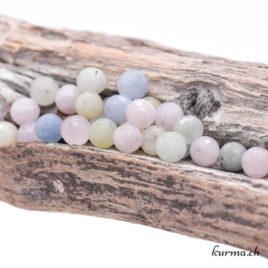


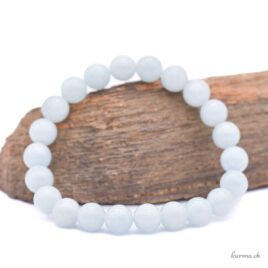
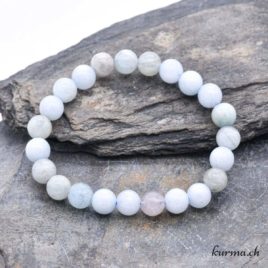
The virtues and properties of Aquamarine in lithotherapy
Is there a difference between aquamarine, aquamarine and blue beryl?
None at all! They're all the same mineral from the silicate group. "Aquamarine" comes from the Latin aqua marina, meaning "sea water". The name "blue beryl" is used to distinguish it from other beryls, such as Morganite or pink beryl, yellow beryl or heliodore, oremerald or green beryl, for example.
What is the symbolic meaning of aquamarines?
Aquamarine is spring water that reflects purity and clarity, tranquil seawater on which the reflections of the rising sun dance, a limpid and flowing river. Aquamarine is pure water that calms your anger, soothes your tension, tames your excess fire and helps you rediscover calm and harmony.
Water is the color of emotions and one of Aquamarine's properties is to teach you to better manage your emotions, to avoid excessive and destructive emotional reactions such as hysteria or aggression and to express your feelings. When unacknowledged and unexpressed emotions build up inside, a "dam" can be created in the throat, preventing energy from flowing normally. When a dam bursts, the water becomes uncontrollable and often wreaks havoc.
Particularly luminous and radiatingpurifying energies, Aquamarine is there to bring clarity to your mind. It clears away superfluous thoughts and widens your vision so you can better perceive the ocean of possibilities before you. It invites you to express your feelings clearly and connects you to your intuition and clairvoyant gifts so that you can choose the path(s) that will enable you to navigate as close to yourself as possible.
One of Aquamarine's finest virtues is its ability to encourage expression, communication and listening. It is a muse for all that concerns the oral arts, such as singing. With Aquamarine, it's often easier to express yourself with kindness and clarity, while avoiding misunderstandings. It's the stone to have when you have to talk to someone with whom you're having trouble getting along, or with whom you're creating a mirror effect that's likely to hit you right in the feels.
Physically, it soothes the eyes and can help improve vision in cases of myopia and hyperopia. It is recommended for allergic reactions (particularly hay fever) and can relieve autoimmune diseases and chronic sinusitis or otitis. It can also soothe toothache, torticollis and neck tension. It supports the immune system, balances hormonal secretions and regulates thyroid function.
How to use an Aquamarine
Wear an Aquamarine on you, in your pocket or as a piece of jewelry to benefit from its virtues every day.
To relieve tension in the neck area, take a moment to relax with an Aquamarine placed on the back of your neck.
To soothe your eyes, place an Aquamarine every evening on your closed eyelids.
Where to place an Aquamarine?
An Aquamarine in your living space will diffuse gentle and feminine energies, conducive to respectful communication between inhabitants.
Whether in your bedroom or your living room, it will help you relax and enjoy a good night's rest.
You can also place it in your bathroom to symbolize the element of water and take baths with it.
Aquamarine purification
Recharging Blue Beryl
Moon, running water, wind/breath, singing bowl, fumigation, shape waves, prayers...Chakra
5ᵉ Chakra - ThroatAstrological signs
Gemini, Aquarius, Pisces and LibraElement
WaterAquamarine in mineralogy
Like Morganite, Heliodore and Emerald, Aquamarine is a variety of beryl. More precisely, it's an aluminum and silicate composed of potassium, lithium, sodium and hydrogen, as well as traces of iron, which give it its translucent blue to blue-green hue, sometimes transparent. It crystallizes as a hexagonal prism.
Adulterations are numerous and difficult to detect, as aquamarine can be heated to intensify its color and give it a deceptive added value. And by irradiation, colorless or yellow beryls turn blue.
The story of Aquamarine
This name was given during the Renaissance, in the Middle Ages and in Antiquity it was simply called Blue Beryl.
Its best-known use throughout history is and as a protective talisman for sailors. It was said to keep the sea calm and safe. The Greeks associated it with Poseidon, the god of the sea and considered it the treasure of mermaids.
The Romans used to engrave a frog on their Aquamarine jewelry to reconcile enemies.
The Chinese associated it with the goddess Guanyin, protector of women and children, symbol of love and unconditional compassion and for the Mayans, this stone was linked with Akna, the goddess of birth and maternity. For the Celts, it symbolized the original matrix and for the Slavs, it was associated with Kupala, the mother water goddess of magic, summer and medicinal herbs.
In the Middle Ages, it was used as an anti-poison, to improve digestion and for divination purposes.
Lithotherapy
- Element(s) :
- Zodiac(s) :
- Libra, Gemini, Pisces, Aquarius
- Purification :
- Singing bowl, Water, Fumigation, Moon, Form waves, Breath
- Illness(es) :
- Autoimmune
- Physics :
- Cervical, Tooth, Digestive (System), Poisoning, Hormonal (secretions), Hormones (regulation), Immune (System), Neck, Ears, Sinuses, Thyroid, Eyes
- Emotional :
- Love, Emotional wound, Clarity, Anger, Stress, Balance
- Spiritual :
- Clear meaning, Harmony, Intuition, Protection, Purification
- Miscellaneous :
- Childbirth, Pregnancy, Protection, Relationship (family)
Mineralogy
- Hardness :
- 7.5-8
- Moths scale:
- 7, 8
- Strunz classification :
- Silicate
- Crystalline system :
- Hexagonal
- Chemical element :
- Be, Al, Si, O
- Line color :
- White
- Density :
- 2.65-2.75
- Cleavage :
- Imperfect
- Fracture:
- Uneven conchoidal
- Transparency :
- Transparent to opaque
- Refringence :
- 1,564 - 1,596
- Birefringence :
- 0.004-0.007; uniaxial negative
- Pleochroism :
- Clean, pale blue, almost colorless, blue to blue-green
- Absorption spectrum :
- 537, 456, 427
- Fluorescence :
- Null
- Colors :
- Colorless to greenish blue
Other Beryls
*Please note! Some minerals may be toxic and must not be licked or ingested (as such or in the form of powder, elixir or stone water) or be in prolonged contact with the skin or mucous membranes.
*The information on the stones described here are general indications based on our research and experience, and are not exhaustive.
Reproduction in whole or in part of this content is prohibited. More info



